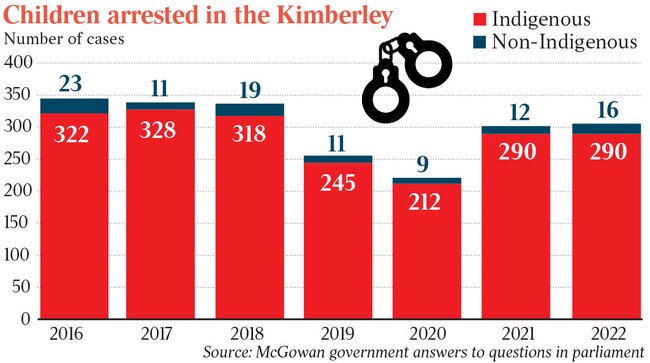Indigenous youth crime crisis plan for the Kimberley
An unconventional program is being rolled out across the strife-torn Kimberley, where more than 95pc of children arrested since 2016 have been Indigenous.
An unconventional crime prevention program is being rolled out across the strife-torn Kimberley, where more than 95 per cent of children arrested since 2016 have been Indigenous.
The McGowan government’s response to a youth crime crisis in the far northwest corner of Australia has so far involved sending extra police to the region and striking a deal to divert juvenile offenders to work on an Aboriginal-owned pastoral station. Now the government is turning its attention to widespread early intervention in a program originally designed to help just 120 of the state’s most troubled families.
The Target 120 program will send community youth officers to work with Indigenous families in the Kimberley if their children have come to the attention of police three or more times. In the towns where the program has been trialled since 2019, police contacts among children have fallen an average 65 per cent. In the Kimberley town of Kununurra, where local Aboriginal people run the program, police contacts have fallen 78 per cent.
The program, which helps families identify and solve all manner of problems, will soon operate in every Kimberley town except the port of Wyndham.

Data tabled in state parliament shows that 2005 of the 2100 juveniles arrested in the Kimberley over the past seven years have been Aboriginal and Torres Strait Islander children. In the first 11 months of 2022, 306 juveniles aged 10 to 17 were arrested in the Kimberley and 290 of those were Indigenous. The arrest figures for Indigenous juveniles in the Kimberley are a significant over-representation: 41 per cent of the region’s 35,000 residents are Indigenous according to 2021 Census data. The proportion is higher in some towns such as Halls Creek, where 72 per cent of residents are Indigenous.
Labor MP for the Kimberley Divina D’Anna said behind each arrest there was a story of trauma and disadvantage.
“There is a need for ongoing support for our communities and families and diversionary programs like night patrols, youth engagement programs and other family support programs,” Ms D’Anna said.
“With the Target 120 program rolling … I hope to see these statistics reduce and see families and communities supported to steer young people away from the system and towards a more positive journey for themselves and their families and communities.
“We need to recognise the need to try different approaches. “
Greens MP Brad Pettitt asked for the arrest data to be tabled because he believed it would underscore the need for “upstream interventions and investments”.
The McGowan government released the figures as Halls Creek prepared to hold a crime summit on Thursday. Halls Creek shire president Malcolm Edwards told The Australian on Tuesday children who fell into crime in the area were often dealing with a range of problems at home. This included overcrowding.
He said the shire collected household rubbish twice a week because once a week was inadequate for the numbers of people living in each home. “In Halls Creek, 82 per cent of houses are overcrowded and I’m talking about more than a dozen people in a three-bedroom house.
“The overcrowding leads to all sorts of problems. It’s not a good environment for anyone.”



To join the conversation, please log in. Don't have an account? Register
Join the conversation, you are commenting as Logout